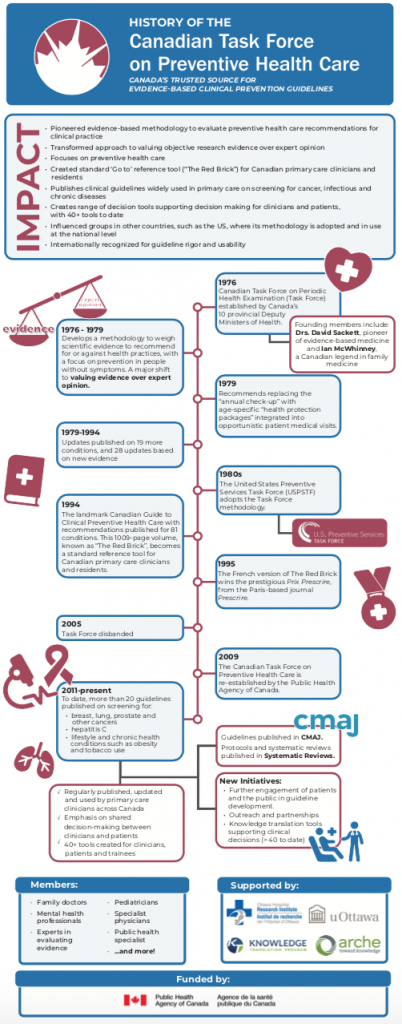History
The Canadian Task Force on Preventive Health Care, previously known as the Canadian Task Force on Periodic Health Examination, was established in September 1976 by the Conference of Deputy Ministers of Health of the ten Canadian provinces. From 1976–1979, a methodology was developed for weighing scientific evidence to make recommendations for or against including preventive manoeuvres in the periodic health examination of asymptomatic people.
The Task Force recognized then, as it does now, that in clinical practice, caregivers dealing with individual patients must make binary decisions—“do it” or “don’t do it”. It also recognizes, however, that for many preventive interventions, the scientific evidence does not lend itself to such simple two-dimensional alternatives. The particular characteristic that distinguishes the Task Force methodology from traditional approaches to decision-making on prevention issues is that evidence takes precedence over consensus.
The first Task Force report, published in 1979, reviewed the scientific evidence for the preventability of 78 conditions and arrived at an important central recommendation, namely that the undefined “annual check-up” should be abandoned and replaced with a series of age-specific “health protection packages” implemented during the course of medical visits for other purposes.
From 1979 to 1994, the Task Force published 9 updates evaluating the preventability of 19 conditions not considered previously, and revising 28 earlier reports in the light of new evidence. In 1994, it published a landmark compilation of recommendations for 81 conditions, called The Canadian Guide to Clinical Preventive Health Care. This 1009-page volume, known as “The Red Brick”, has become a standard reference tool for Canadian primary care clinicians. In 1995, the French version of The Red Brick won the prestigious Prix Prescrire, awarded annually by the Paris-based journal Prescrire, to a medical or pharmaceutical publication.
In the 1980s the Task Force methodology was adopted, with minimal modification, by the United States Preventive Services Task Force (USPSTF). It has now been applied successfully by the both the Canadian and U.S. Task Forces to evaluate the preventability of over 200 conditions and has achieved international recognition as a basis for developing guidelines for clinical practice and public health policy. The Canadian and U.S. Task Forces continue to enjoy a close, constructive collaboration. Canadian, along with U.S. Preventive Services, Task Force recommendations are currently being used by the U.S. Department of Health and Human Services’ “Put Prevention into Practice” initiative to create a resource for clinicians to use when considering preventive care.
In 2005, the Task Force was disbanded.
In 2010, the Task Force was re-established with the support of the Public Health Agency of Canada (PHAC) and a renewed commitment and vision to continue its 25-year tradition of excellence.

